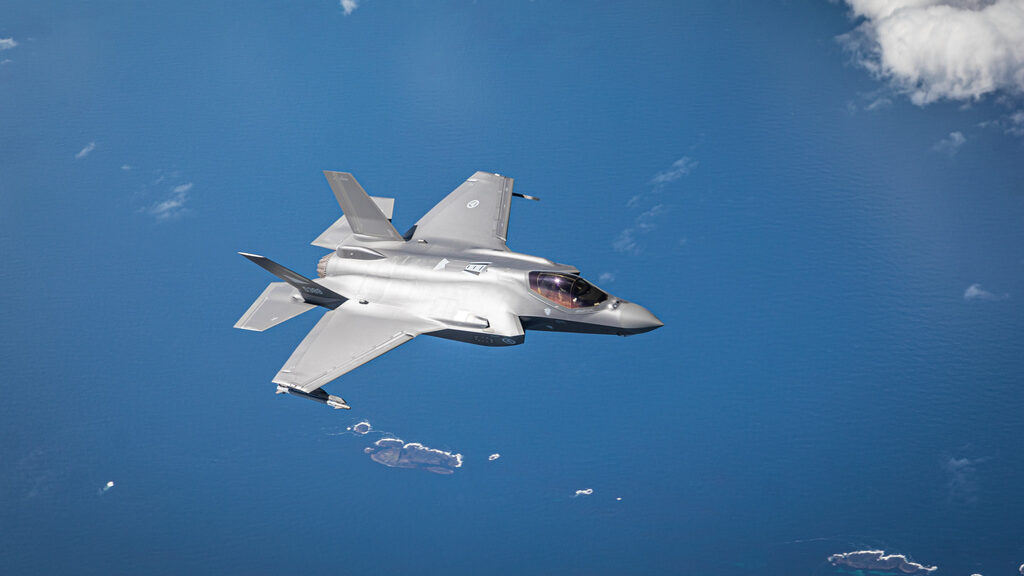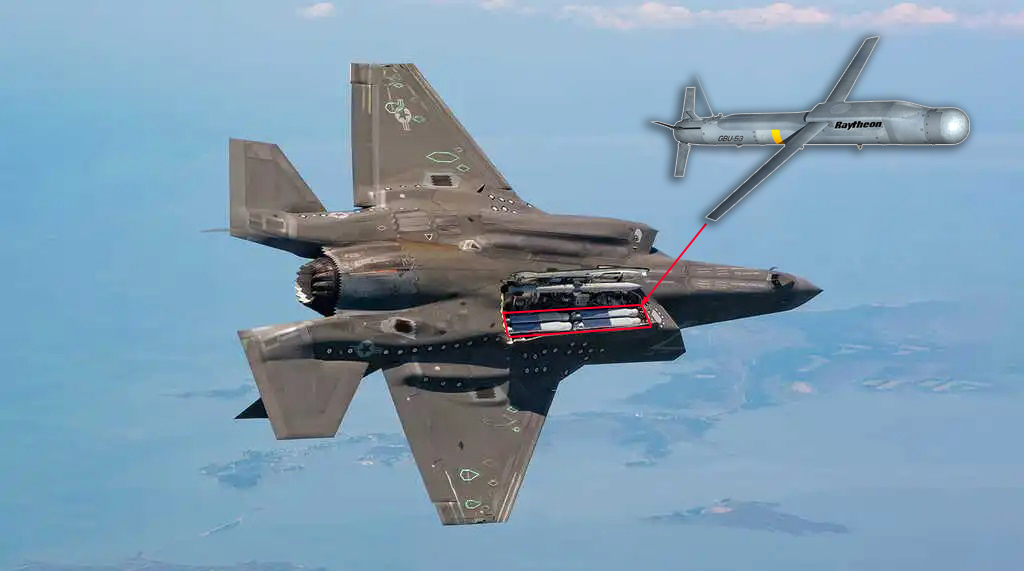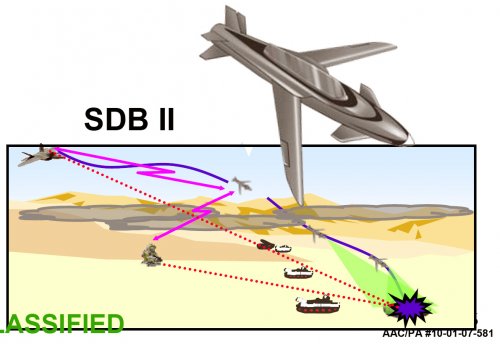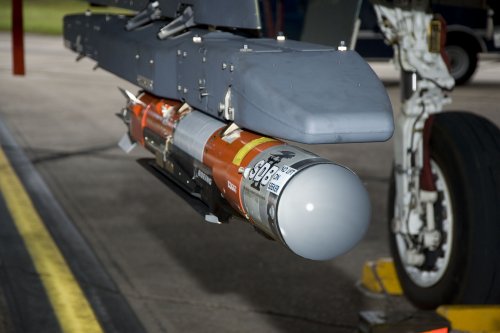You are using an out of date browser. It may not display this or other websites correctly.
You should upgrade or use an alternative browser.
You should upgrade or use an alternative browser.
Small Diameter Bomb II
- Thread starter flateric
- Start date
- Joined
- 21 April 2009
- Messages
- 13,148
- Reaction score
- 5,988
Thanks, I have been trying to find SDB theoretical weapons loadouts for various platforms like the B-2, B-52 and B-1. I remember reading somewhere (cannot find it now) that the B-52 in a low threat counter air environment can carry close to 200 SDB's? With GPS means 200 aimpoints per sortie, incredible.
Lampshade111
ACCESS: Confidential
- Joined
- 5 October 2008
- Messages
- 151
- Reaction score
- 12
Indeed, quite impressive.
Any details on what type of explosive and how much are in the SBD?
Any details on what type of explosive and how much are in the SBD?
- Joined
- 4 May 2008
- Messages
- 2,440
- Reaction score
- 674
I hope that's just a (poor) artist's impression of what an SDB II would look like. I can't think of more complicated and impractical layouts than a forward-swept wing three-lifting surface. Are they trying to achieve post-stall maneuverability ???
The current configuration works just fine.
The current configuration works just fine.
- Joined
- 16 April 2008
- Messages
- 8,358
- Reaction score
- 10,195
Lampshade111 said:Indeed, quite impressive.
Any details on what type of explosive and how much are in the SBD?
Wikipedia says 38 lb (17 kg) of AFX-757.
The actual warload for the B-52 seems to be only 32 SDBs (one BRU-61/A rack with four SDBs on each station of the Common Strategic Rotary Launcher).
http://www.spacedaily.com/reports/Boeing_Developing_New_Smart_Bomb_Bay_Capability_For_B_52_999.html
The B-1 could carry 96 SDBs, because it has three Conventional Rotary Launchers that could each carry eight BRU-61 racks. (This hasn't been done yet, but it is in the Air Force's "wish list" for future projects.)
The B-2 has been widely cited as potentially carrying 216 SDBs, but Global Security has a nice dissection of why that isn't likely (short form; the weight of the SDBs and their racks would be about twice the nominal capacity of the B-2's bomb bay.)
http://www.globalsecurity.org/wmd/systems/b-2.htm
Colonial-Marine
UAVs are now friend, drones are the real enemy.
- Joined
- 5 October 2009
- Messages
- 1,192
- Reaction score
- 687
I think the weight figure stated by Wikipedia for the bomb's explosive content is rather inaccurate. I can't find any common consensus but several sources I put above Wikipedia give different weights.
- Joined
- 18 March 2008
- Messages
- 3,532
- Reaction score
- 721
sferrin said:Hopefully they come up with a different nose if they want to drop them supersonically. ???
What makes you think they can't drop them at supersonic speed with the semi-sphere nose? Plenty of very fast things with such an aerodynamic front end.
- Joined
- 3 June 2011
- Messages
- 17,300
- Reaction score
- 8,993
Abraham Gubler said:sferrin said:Hopefully they come up with a different nose if they want to drop them supersonically. ???
What makes you think they can't drop them at supersonic speed with the semi-sphere nose? Plenty of very fast things with such an aerodynamic front end.
Just seems like it would lose velocity quicker.
- Joined
- 9 October 2009
- Messages
- 19,805
- Reaction score
- 10,301
Since the F-35 news thread is currently out of action:
http://insidedefense.com/share/167668
http://insidedefense.com/share/167668
- Joined
- 3 June 2011
- Messages
- 17,300
- Reaction score
- 8,993
Grey Havoc said:Since the F-35 news thread is currently out of action:
http://insidedefense.com/share/167668
Knowing why it's out of action why would you then attempt to start it in another thread?
- Joined
- 11 March 2006
- Messages
- 8,606
- Reaction score
- 3,046
sferrin said:Knowing why it's out of action why would you then attempt to start it in another thread?
We can let this pass as a post about the SDB, not about the F-35, I think ...
bring_it_on
I really should change my personal text
- Joined
- 4 July 2013
- Messages
- 3,123
- Reaction score
- 2,234
bring_it_on
I really should change my personal text
- Joined
- 4 July 2013
- Messages
- 3,123
- Reaction score
- 2,234
“There’s more possible for StormBreaker – options like adding propulsion or swapping out the seeker depending on the mission. The hardware and software can cover a range of threats,” Howlett said. “It’s a very flexible weapon – one-of-kind with world class technology.”
Another key benefit of the StormBreaker system is its networking capabilities. This means one platform could launch it but hand off controls to another. That will be an important capability as the U.S. military aims to connect sensors, platforms and weapon systems across the traditional domains of land, air, sea and space.
“It’s inherent with this weapon and absolutely critical going into a more connected – JADC2 (Joint All Domain Command and Control) – battlespace environment,” Howlett said.
Raytheon Missiles & Defense used digital technologies – both tools and processes – to develop StormBreaker.
“It’s certainly an advanced weapon in terms of its design and development and how we’re architecting it for the future. It’s extremely capable now and we’re just getting started,” Howlett said.
To verify system performance, the team uses an integrated flight simulation, or IFS, and literally runs thousands of iterations in tandem with the Air Force using data from testing to continuously improve simulation accuracy.
“It allows us to find and address potential issues before real-life testing, which drives down schedule and cost,” Howlett said.
The business is also using agile methods to deliver rapid capability updates through software changes.
“Each aircraft has unique software, so we need to ensure we’re integrating appropriately with that software,” Howlett said.
In 2020, the Air Force cleared the system for use on the F-15E, making it the first aircraft to carry the weapon. After achieving this milestone, the Air Force and Raytheon Missiles & Defense dropped 14 StormBreaker smart weapons in the 2021 Weapons System Evaluation Program. The successful evaluation and tactics development paves the way for its use by combat air forces.
The F-15E can carry five groups of four StormBreaker smart weapons, for a total of 20 munitions. Depending on the mission, the F-15EX Strike Eagle II can carry more than 16 StormBreaker weapons.
The F/A-18E/F Super Hornet will be the second fighter jet to add the weapon when it reaches initial operating capability.
Raytheon Missiles & Defense is integrating the StormBreaker weapon on the F-35 Joint Strike Fighter. The first-ever StormBreaker munition drop test from an F-35 was conducted in late 2021 to test the communication link between the weapon and a secondary aircraft.

News
bring_it_on
I really should change my personal text
- Joined
- 4 July 2013
- Messages
- 3,123
- Reaction score
- 2,234
They need to release actual test video.
F-35B test drop (shared by the US Air Force)
Attachments
- Joined
- 21 April 2009
- Messages
- 13,148
- Reaction score
- 5,988
Gunfighters’ first shots with new smart bomb, StormBreaker
The 391st Fighter Squadron became the first operational unit to use the GBU-53/B, the Air Force’s new small diameter bomb known as StormBreaker, Nov. 2 at the Utah Test and Training Range.
www.acc.af.mil
Forest Green
ACCESS: Top Secret
- Joined
- 11 June 2019
- Messages
- 4,959
- Reaction score
- 6,330

US clears Norway for $293 million small diameter bomb sale to equip F-35 fleet - Breaking Defense
Separately, the US cleared a potential $15 billion sale to Poland for Patriot air defense systems and related equipment.
Scott Kenny
ACCESS: Above Top Secret
- Joined
- 15 May 2023
- Messages
- 5,851
- Reaction score
- 4,612
Or if the same interstage will work on both SDB and SDB2?Just as Boeing and SAAB have developed the GLSDB using the SDB I has another variant been considered using the SDB II?
Or if the same interstage will work on both SDB and SDB2?
I can't see any reason why not.
Forest Green
ACCESS: Top Secret
- Joined
- 11 June 2019
- Messages
- 4,959
- Reaction score
- 6,330
Forest Green
ACCESS: Top Secret
- Joined
- 11 June 2019
- Messages
- 4,959
- Reaction score
- 6,330
Forest Green
ACCESS: Top Secret
- Joined
- 11 June 2019
- Messages
- 4,959
- Reaction score
- 6,330

Italy Will Get GBU-53/B StormBreaker For Its F-35s
The weapon, also known as Small Diameter Bomb II, is currently being integrated on the F-35 as part of the Block 4 upgrades. Italy is acquiring the
- Joined
- 16 April 2008
- Messages
- 8,358
- Reaction score
- 10,195
In regards to the Boeing/SAAB GLSDB I wonder if the team has also considered the SDBII?
SDB-I is a Boeing product, SDB-II is Raytheon. I can't imagine Boeing privately offering a weapon system based on someone else's payload, and I can't imagine Raytheon permitting it anyway.
Scott Kenny
ACCESS: Above Top Secret
- Joined
- 15 May 2023
- Messages
- 5,851
- Reaction score
- 4,612
While true, if the same interstage fits both SDB1 and SDB2 it's going to work.SDB-I is a Boeing product, SDB-II is Raytheon. I can't imagine Boeing privately offering a weapon system based on someone else's payload, and I can't imagine Raytheon permitting it anyway.
I can't imagine Boeing privately offering a weapon system based on someone else's payload, and I can't imagine Raytheon permitting it anyway.
If the US DoD is paying for the manufacture of GLSDB I can see it making the two companies get together and paying them to work out the details.
While true, if the same interstage fits both SDB1 and SDB2 it's going to work.
A good point, if the SDBI and SDBII boat-tails are the same with the same diameter then the booster adapter should fit otherwise it should be hard for a modified booster adapter be designed and built to mount the SDBII to the booster.
- Joined
- 16 April 2008
- Messages
- 8,358
- Reaction score
- 10,195
While true, if the same interstage fits both SDB1 and SDB2 it's going to work.
No reason to think it would be the same. SDB1 has a rounded square cross-section at the tail, while SDB2 is round.
- Joined
- 16 April 2008
- Messages
- 8,358
- Reaction score
- 10,195
If the US DoD is paying for the manufacture of GLSDB I can see it making the two companies get together and paying them to work out the details.
It can be done, certainly, but it would be a very odd relationship. And given that it's an acquisition not for DoD but strictly for Ukraine, it seems like sticking to the nearly off-the-shelf version is far more sensible.
And Boeing of course had it own SDB-II design and a version of SDB-I with a laser seeker, either of which might be preferable.
Scott Kenny
ACCESS: Above Top Secret
- Joined
- 15 May 2023
- Messages
- 5,851
- Reaction score
- 4,612
Ah, is that the case? bugger.No reason to think it would be the same. SDB1 has a rounded square cross-section at the tail, while SDB2 is round.
Well, time for Raytheon to make their own GLSDB2 interstage...
And given that it's an acquisition not for DoD but strictly for Ukraine, it seems like sticking to the nearly off-the-shelf version is far more sensible.
If it is produced for Ukraine and it is used with great success (To the detriment of the Russian of course) I can see the US DoD taking notice along with other countries using MLRS and wanting to add a GLSDBII to their inventory (Taiwan would no doubt love it).
And Boeing of course had it own SDB-II design
Which hasn't been put into production.
a version of SDB-I with a laser seeker
True but the problem with such a seeker is that you need a laser-designator within line of sight of the target.
Scott Kenny
ACCESS: Above Top Secret
- Joined
- 15 May 2023
- Messages
- 5,851
- Reaction score
- 4,612
Which is why I was asking about GLSDB2. IIR and MMWR are much more conducive to the kinds of strikes that Ukraine needs to make.True but the problem with such a seeker is that you need a laser-designator within line of sight of the target.
On the other hand, the average UAF soldier probably has designating-capable quads down to the backpack level.Which is why I was asking about GLSDB2. IIR and MMWR are much more conducive to the kinds of strikes that Ukraine needs to make.
Id argue that a thermobaric SDB-I to knock out the various trenches that block Ukrainian advances would be a godsend for the current stagnating situation.
- Joined
- 16 April 2008
- Messages
- 8,358
- Reaction score
- 10,195
On the other hand, the average UAF soldier probably has designating-capable quads down to the backpack level.
Id argue that a thermobaric SDB-I to knock out the various trenches that block Ukrainian advances would be a godsend for the current stagnating situation.
Hitting trenches with extended-range standoff weapons seems counterintuitive. After all, your troops and general purpose artillery need to be close by to exploit a breached trenchline.
The existing GMLRS-AW seems like it would be fine, and a better (easier) platform for a thermobaric warhead if desired. Remember, the SDB warhead is tiny (36 lbs HE) compared to 200 lbs for GMLRS.
Forest Green
ACCESS: Top Secret
- Joined
- 11 June 2019
- Messages
- 4,959
- Reaction score
- 6,330
38lbs.The existing GMLRS-AW seems like it would be fine, and a better (easier) platform for a thermobaric warhead if desired. Remember, the SDB warhead is tiny (36 lbs HE) compared to 200 lbs for GMLRS.
Boeing GBU-39/B SDB
En 1995, l'USAF lança le programme MMTD (Miniaturized Munitions Technology Demonstration) afin de construire une nouvelle génération de bombes de 113 kg (250 lbs). Le but de ces bombes est …
Similar threads
-
Ground Launched Small Diameter Bomb (GLSDB)
- Started by Triton
- Replies: 119
-
-
-
Compilation of Energy Efficient Concepts in Advanced Aircraft Design...
- Started by Grey Havoc
- Replies: 0
-




